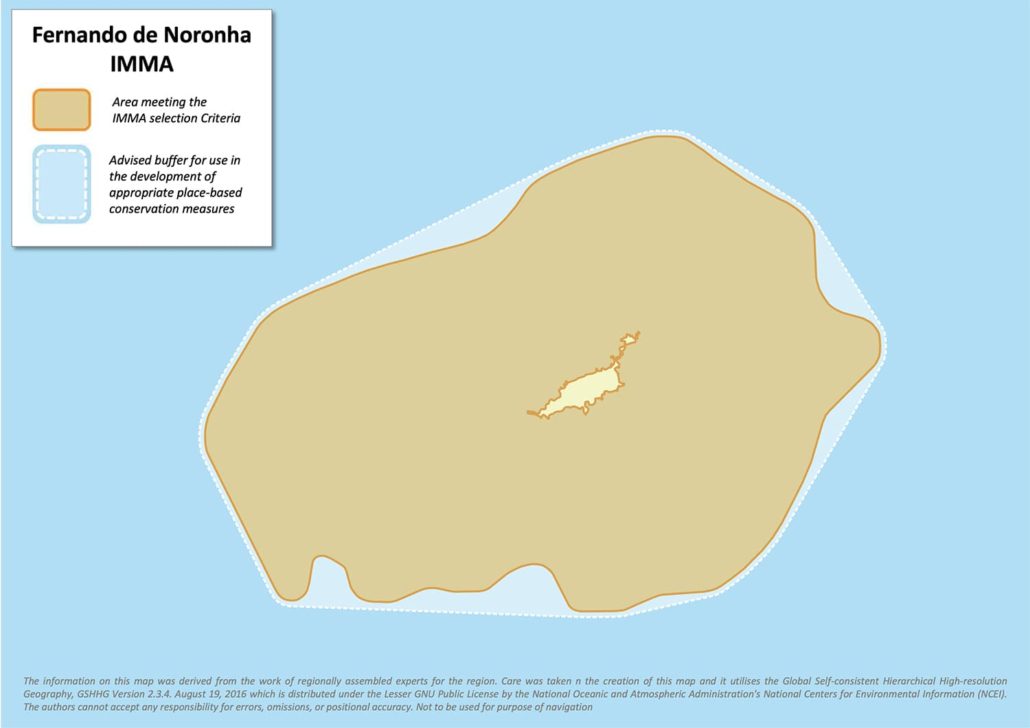Fernando de Noronha IMMA
Size in Square Kilometres
2 032 km2
Qualifying Species and Criteria
Spinner dolphin – Stenella longirostris
Criterion B (1)
Download fact sheet
Summary
The Fernando de Noronha Archipelago (3º51’S; 32º24’ W) is 361 km off the northeast coast of Brazil. It is the emerged top of a chain of underwater mountains of volcanic origin between the middle of the Atlantic ocean and Brazil. Its location, geological structure and oceanographic conditions provide refuge and food resources for ocean organisms, creating suitable conditions for the concentration of cetaceans. The archipelago is composed of two Federal Conservation Units and is considered by UNESCO as 1) A biosphere Reserve; 2) A World Natural Heritage Area (Recognized in 2001). The IMMA is important habitat for a resident population of spinner dolphins (Stenella longirostris) and the inshore waters are an important daytime resting area. At Fernando de Noronha Archipelago, large concentrations of spinner dolphins of up to ca. 2000 individuals are recorded throughout the year at the cove known as Dolphins’ Bay. Ten species of cetaceans have already been registered in the area. This IMMA falls within the Banks Chain of Northern Brazil and Fernando de Noronha EBSA, which already recognised that the Archipelago of Fernando de Noronha is used as habitat throughout the year by a population of spinner dolphin (Stenella longirostris).
Description of Qualifying Criteria
Criterion B: Distribution and Abundance
Sub-criterion B1: Small and Resident Populations
This IMMA fulfils sub-criterion B1 due to the presence of a resident population of spinner dolphins (S. longirostris) which are observed on about 90% of the days of the year. The spinner dolphins have a daily cycle in the area consisting of nocturnal feeding, in more distant areas around the archipelago, and daytime concentrations in bays (mainly “Baía dos Golfinhos” and “Entre-Ilhas”), where dolphins perform resting, reproduction, parental care and social interactions. At Fernando de Noronha Archipelago, large concentrations of spinner dolphins of up to ca. 2000 individuals are recorded throughout the year at the cove known as Dolphins’ Bay (Silva-Jr. et al, 1996, Silva-Jr. et al, 2005a). The number of spinners observed averaged around 300 per day, with a maximum of about 2700 in a single day (Silva & Silva Júnior, 2009; Silva Júnior at al, 2005a; Silva Júnior at al, 2005b; Silva Júnior at al, 2007; Tischer at al, 2013; Tischer at al, 2017; De Carli at al, 2017). Spinner groups congregate in Dolphin’s Bay during the morning and early afternoon, leaving the bay in the afternoon to forage in the open sea (Silva-Jr. et al, 1996).
There was also a constant frequency of spinner dolphins in Baía dos Golfinhos, with the daily number varying between the seasons. The highest daily average of concentration was confirmed for the dry season (September to February), with an average of 155 individuals and the lowest average was in the rainy season (March to August), with a minimum daily average of 26 individuals (Silva & Silva-Jr, 2009)
This IMMA falls within the Banks Chain of Northern Brazil and Fernando de Noronha EBSA, which already recognised that the Archipelago of Fernando de Noronha is used as habitat throughout the year by a population of spinner dolphin (Stenella longirostris) (Silva-Jr., 2005).
Supporting Information
De Carli, R.C.; Silva, F.J.L. ; Silva-Jr., J.M. 2017. Daily patterns in aerial activity by spinner dolphins in Fernando de Noronha. Journal of the Marine Biological Association of The United Kingdom. v.1, p.1 – 7.
Silva, F.J.L. & Silva Jr., 2009. Circadian and seasonal rhythms in the behavior of spinner (Stenella longirostris). Marine Mammal Science. , v.25, p.176 – 186.
Silva-Jr., J.M. 2005. Ecologia comportamental do golfinho-rotador (Stenella longirostris) em Fernando de Noronha. Tese de Doutorado. Universidade Federal de Pernambuco, Recife, 2005. 120p Silva Jr, J. M. da (2009) – Projeto Golfinho Rotador: pesquisa e conservação do golfinho-rotador Stenella longirostris Gray, 1828 (Cetacea: Delphinidae) no Arquipélago de Fernando de Noronha, Brasil. In: Mohr, L. V., Castro, J. W. A., Costa, P. M. S. & Alves, R. J. V. (orgs.). Ilhas oceânicas brasileiras: da pesquisa ao manejo. Vol. II, p. 293-319, MMA Secretaria de Biodiversidade e Florestas, Brasília, DF, Brasil. ISBN: 9788577380763.
Silva-Jr, J. M. 2010. The dolphins of Noronha. 1° Edição. São Paulo: Bambu. Available at: https://golfinhorotador.org.br/publicacoes/os-golfinhos-de-noronha-the-dolphins-of-noronha. (Accessed: 7 December 2022).
Silva-Jr., J.M., Silva, F.J.L. & Pereira, J.A.1996. O comportamento do golfinho rotador em F. de Noronha. Anais 14 Encontro Anual de Etologia, Uberlândia, MG, Brasil: 251-262.
Silva Jr., J. M., Silva, F. J. L., Sazima, I. 2005a. Rest, nurture, sex, release, and play: diurnal underwater behaviour of the spinner dolphin at Fernando de Noronha Archipelago, SW Atlantic. Aqua (Neu-Isenburg). , v.9, p.161 – 176.
Silva Jr., J. M., Silva, F. J. L., Sazima, I. 2005b. Two presumed interspecific hybrids in the genus Stenella (Delphinidae) in the tropical West Atlantic. Aquatic Mammals., v.31, p.468 – 472.
Silva -Jr., J. M., Silva, F. J. L., Sazima, C., Sazima, I. 2007. Trophic relationships of the spinner dolphin at Fernando de Noronha Archipelago, SW Atlantic.
Teixeira, W., Cordani, U.G., Menor, E.A., Teixeira, M.G. & Linsker, R. 2003. Arquipélago Fernando de Noronha: o paraíso do vulcão. Terra Virgem, São Paulo.
Tischer, M.C., Silva-Jr., J.M., & Silva, F.J.L. 2013. Interaction of spinner dolphins (Stenella longirostris) (Cetacea, Delphinidae) with boats at the Archipelago of Fernando de Noronha, Brazil. Pan-American Journal of Aquatic Sciences. 8. 339-346.
Tischer, M. C., De Carli, R. C. Silva, F. J. L.; Silva Jr, J. M. 2017. Tourism growth altering spinner dolphins’ area of occupation in Fernando de Noronha Archipelago, Brazil. Latin American Journal of Aquatic Research. v.45, p.807 – 813.


